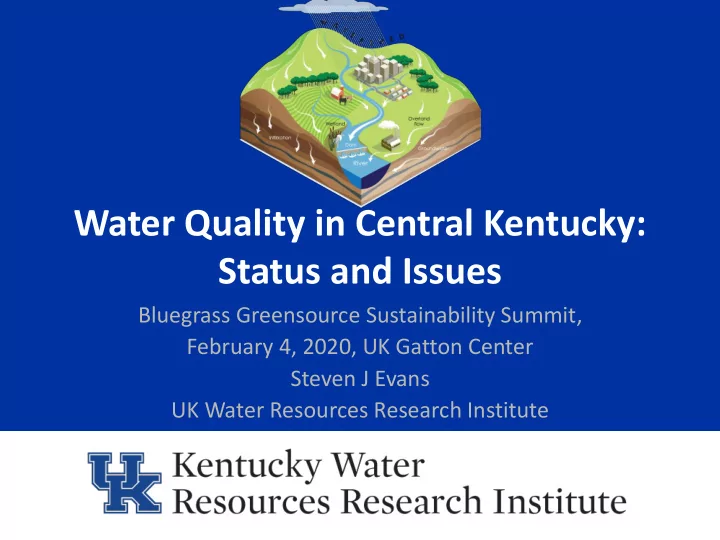

Water Quality in Central Kentucky: Status and Issues Bluegrass Greensource Sustainability Summit, February 4, 2020, UK Gatton Center Steven J Evans UK Water Resources Research Institute
Water Quality in the 20 County Area
Licking River River Basins Salt River About 5250 miles of streams (1:100,000) • 33% in ag areas Kentucky River Green River Upper Cumberland River
Land Use Pasture / Hay – 47% Forest – 35% Development – 10% Row Crop – 4% • About 5,250 miles of streams (1:100,000) 33% in ag areas • Horse / cattle farms
% Slope White = 0% Yellow = 6% Orange = 15% Red = 50% Forested on steeper slopes Pasture or city on flat land
Karst
Karst Mapped Sinkhole Mapped Karst Basin Karst areas present unique challenges for tracing pollution to its source.
Source Water Protection Zone 1: Critical Zone 2: Responsibility Zone 3: Potential Impact
Problems and Causes
Fish Consumption Non-Support Partial Support Full Support Unassessed Mercury / methylmercury: • Sources: atmospheric sources, combustion of fossil fuels, lights, mining discharges • Bioaccumulates in fish
Recreational Use Non-Support Partial Support Full Support Unassessed Thicker Dash = Secondary Use Impact Primary Secondary
Primary Secondary Recreational Use 2016 303(d) List Fecal indicator Bacteria (E.coli or Fecal Coliform) • Primary Contact Recreation = 491 miles • Secondary Contact Recreation = 72 miles Suspected Sources: • Agriculture – 73% • (Livestock 46%, Crop 2%, Unspecified 24%) • Unknown 19% • Urban Runoff – 18% • Sanitary Sewer – 15% • Onsite Sewer or Package Plant – 12% • Other – 4%
Cattle per 100 acres of Farmland, 2012 Contains some of the highest densities of cattle by farmland ~238,000 cows ~57,000 horses ~24,000 sheep ~8,000 chickens ~3,000 pigs
Public Sanitary Sewer Availability (2010) Some counties do not have abundant access to sanitary sewer
Sanitary Sewer System and Private Lateral Lines
Warmwater Aquatic Habitat Non-Support Partial Support Full Support Unassessed
Warmwater Aquatic Habitat 2016 303(d) List 755 Miles of Impaired Waterways 1.7 pollutants on average (counting nutrients as 1) Pollutants: • Nutrient / Eutrophication = 63%, 479 miles • Sedimentation / Siltation = 57%, 434 miles • Dissolved ions = 18%, 134 miles • Organic Enrichment (Sewage) = 17%, 128 miles • Cause unknown = 11%, 81 miles • Chlorine = 5%, 36 miles • Lead = 5%, 34 miles • Iron = 2%, 15 miles • Other = 1%, 8 miles
Nutrient / Eutrophication • Sources • Fertilizer • Manure / Pet Waste • Sewage • Geology • Decay • Eutrophication: • Abundant algal growth • Dissolved oxygen depletion • Fish death • Harmful toxins • Taste and odor treatment
Sedimentation / Siltation Source: FISRWG, 1998
Sedimentation / Siltation Widening Aggradation Stream’s elevation increases Stream width increases Aggradation through bank material due to deposition of bed removal from erosion, sediment failure, and toe scouring. Narrowing Widening Stream (Bank Disturbance (Bank Retreat) Advancement) Degradation Narrowing Stream’s elevation Stream width decreases due Degradation decreases due to erosion of to bank building by slumping, bed sediment and incision toe benches, or berms.
Sedimentation / Siltation
Warmwater Aquatic Habitat 2016 303(d) List Suspected Sources: • Agriculture – 70% • (Livestock 43%, Crop 18%, Unspecified 27%) • Urban Runoff – 23% • Habitat Loss of Modification – 23% • Sanitary Sewer – 20% • Other – 15% • Roadway Runoff – 11% • Streambank Erosion / Hydromodification – 9% • Construction – 5% • Onsite Sewer / Package Plant – 2%
Potential Solutions • Ag Water Quality Plans • Septic Repair/Replacement • Livestock restriction from • Sanitary Sewer / Private streams Lateral Repair • Alternative water sources • Package Treatment Plant Removal / Replacement • Manure management • Dog Waste Pickup Programs • Riparian planting • Construction site erosion • Stream restoration / and sediment control floodplain reconnection • Minimization of salt use in • Stormwater: slow it down, de-icing spread it out, soak it in • No home phosphorus • Green infrastructure / Low- application without a soil Impact Development test
Recommend
More recommend